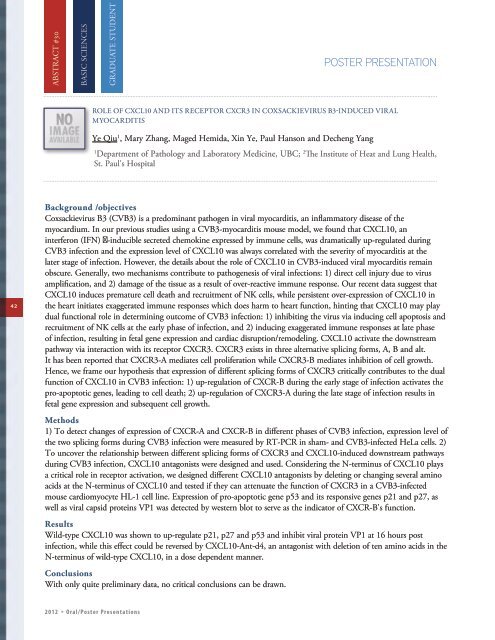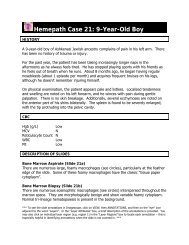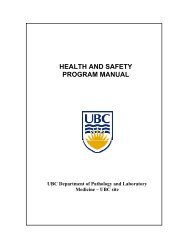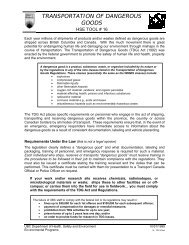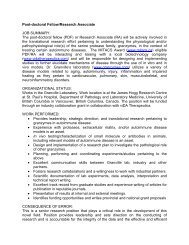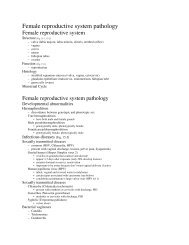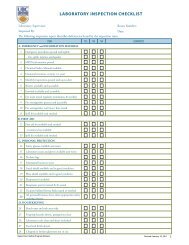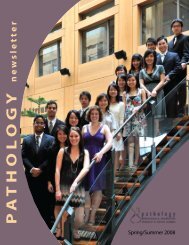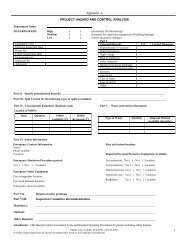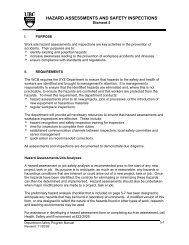Abstract Book - Pathology and Laboratory Medicine - University of ...
Abstract Book - Pathology and Laboratory Medicine - University of ...
Abstract Book - Pathology and Laboratory Medicine - University of ...
You also want an ePaper? Increase the reach of your titles
YUMPU automatically turns print PDFs into web optimized ePapers that Google loves.
ABSTRACT #30BASIC SCIENCESGRADUATE STUDENTPOSTER presentationRole <strong>of</strong> CXCL10 <strong>and</strong> its receptor CXCR3 in Coxsackievirus B3-induced viralmyocarditisYe Qiu 1 , Mary Zhang, Maged Hemida, Xin Ye, Paul Hanson <strong>and</strong> Decheng Yang1Department <strong>of</strong> <strong>Pathology</strong> <strong>and</strong> <strong>Laboratory</strong> <strong>Medicine</strong>, UBC; 2 The Institute <strong>of</strong> Heat <strong>and</strong> Lung Health,St. Paul's Hospital42Background /objectivesCoxsackievirus B3 (CVB3) is a predominant pathogen in viral myocarditis, an inflammatory disease <strong>of</strong> themyocardium. In our previous studies using a CVB3-myocarditis mouse model, we found that CXCL10, aninterferon (IFN) γ-inducible secreted chemokine expressed by immune cells, was dramatically up-regulated duringCVB3 infection <strong>and</strong> the expression level <strong>of</strong> CXCL10 was always correlated with the severity <strong>of</strong> myocarditis at thelater stage <strong>of</strong> infection. However, the details about the role <strong>of</strong> CXCL10 in CVB3-induced viral myocarditis remainobscure. Generally, two mechanisms contribute to pathogenesis <strong>of</strong> viral infections: 1) direct cell injury due to virusamplification, <strong>and</strong> 2) damage <strong>of</strong> the tissue as a result <strong>of</strong> over-reactive immune response. Our recent data suggest thatCXCL10 induces premature cell death <strong>and</strong> recruitment <strong>of</strong> NK cells, while persistent over-expression <strong>of</strong> CXCL10 inthe heart initiates exaggerated immune responses which does harm to heart function, hinting that CXCL10 may playdual functional role in determining outcome <strong>of</strong> CVB3 infection: 1) inhibiting the virus via inducing cell apoptosis <strong>and</strong>recruitment <strong>of</strong> NK cells at the early phase <strong>of</strong> infection, <strong>and</strong> 2) inducing exaggerated immune responses at late phase<strong>of</strong> infection, resulting in fetal gene expression <strong>and</strong> cardiac disruption/remodeling. CXCL10 activate the downstreampathway via interaction with its receptor CXCR3. CXCR3 exists in three alternative splicing forms, A, B <strong>and</strong> alt.It has been reported that CXCR3-A mediates cell proliferation while CXCR3-B mediates inhibition <strong>of</strong> cell growth.Hence, we frame our hypothesis that expression <strong>of</strong> different splicing forms <strong>of</strong> CXCR3 critically contributes to the dualfunction <strong>of</strong> CXCL10 in CVB3 infection: 1) up-regulation <strong>of</strong> CXCR-B during the early stage <strong>of</strong> infection activates thepro-apoptotic genes, leading to cell death; 2) up-regulation <strong>of</strong> CXCR3-A during the late stage <strong>of</strong> infection results infetal gene expression <strong>and</strong> subsequent cell growth.Methods1) To detect changes <strong>of</strong> expression <strong>of</strong> CXCR-A <strong>and</strong> CXCR-B in different phases <strong>of</strong> CVB3 infection, expression level <strong>of</strong>the two splicing forms during CVB3 infection were measured by RT-PCR in sham- <strong>and</strong> CVB3-infected HeLa cells. 2)To uncover the relationship between different splicing forms <strong>of</strong> CXCR3 <strong>and</strong> CXCL10-induced downstream pathwaysduring CVB3 infection, CXCL10 antagonists were designed <strong>and</strong> used. Considering the N-terminus <strong>of</strong> CXCL10 playsa critical role in receptor activation, we designed different CXCL10 antagonists by deleting or changing several aminoacids at the N-terminus <strong>of</strong> CXCL10 <strong>and</strong> tested if they can attenuate the function <strong>of</strong> CXCR3 in a CVB3-infectedmouse cardiomyocyte HL-1 cell line. Expression <strong>of</strong> pro-apoptotic gene p53 <strong>and</strong> its responsive genes p21 <strong>and</strong> p27, aswell as viral capsid proteins VP1 was detected by western blot to serve as the indicator <strong>of</strong> CXCR-B's function.ResultsWild-type CXCL10 was shown to up-regulate p21, p27 <strong>and</strong> p53 <strong>and</strong> inhibit viral protein VP1 at 16 hours postinfection, while this effect could be reversed by CXCL10-Ant-d4, an antagonist with deletion <strong>of</strong> ten amino acids in theN-terminus <strong>of</strong> wild-type CXCL10, in a dose dependent manner.ConclusionsWith only quite preliminary data, no critical conclusions can be drawn.2012 * Oral/Poster Presentations


